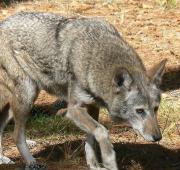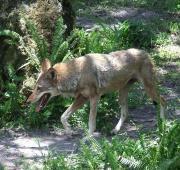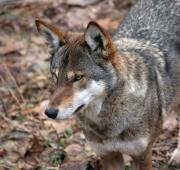 The red wolf is a medium sized species of wolf, found in the coastal marshlands of southern parts of eastern North America. By the 1970s the pure red wolf was thought to be extinct in the wild, but a population has since been reintroduced in North Carolina that is said to now be up to 100 red wolf individuals.
The red wolf is a medium sized species of wolf, found in the coastal marshlands of southern parts of eastern North America. By the 1970s the pure red wolf was thought to be extinct in the wild, but a population has since been reintroduced in North Carolina that is said to now be up to 100 red wolf individuals. The red wolf was roamed across the south-eastern United States from Texas to Florida to New York. The red wolf's historical habitat included areas of forest, swampland and coastal prairies where it would of been one of the top predators. Today however, the world's red wolf population is confined to a protected area in North Carolina.
The red wolf was roamed across the south-eastern United States from Texas to Florida to New York. The red wolf's historical habitat included areas of forest, swampland and coastal prairies where it would of been one of the top predators. Today however, the world's red wolf population is confined to a protected area in North Carolina.


Although red wolves are known to hunt together as a group in order to catch a larger animal such as a deer, red wolves primarily eat smaller ground dwelling animals such as rabbits and rodents. Red wolves also eat birds, raccoons and other small animals. When trying to hunt a larger animal, the red wolf pack works together to confuse and corner their prey.
In their historical range, red wolves were considered to be one of the most dominant predators within their environment, only coming under threat from larger canines such as gray wolves or the occasional coyote. Human hunters wiped out the red wolf population in large parts of their natural range, and the population was finally thought to become extinct primarily due to habitat loss.
Red wolves are usually able to reproduce by the time they are 2 years old and begin mating in the warmer spring months of February and March. The female red wolf gives birth to a litter of up to 10 cubs after a gestation period that lasts for around 60 days. Cubs are born blind and are nursed by the rest of the pack until they are able to hunt for themselves and either remain with their parents or leave to start a pack of their own.
Today, the red wolf is no longer extinct in the wild since their reintroduction to North Carolina in 1987, and the population their is now thought to be just over 100 red wolf individuals. Nevertheless, the red wolf is still considered to be a critically endangered animal and is regarded as the 10th most endangered animal species in the world.

